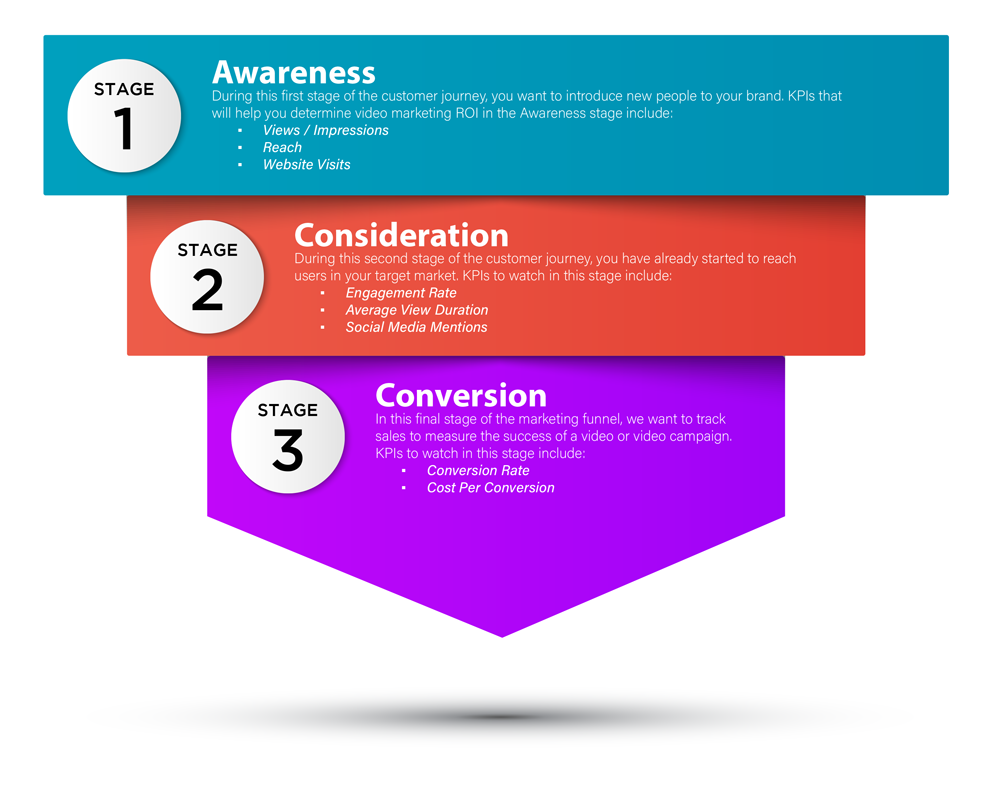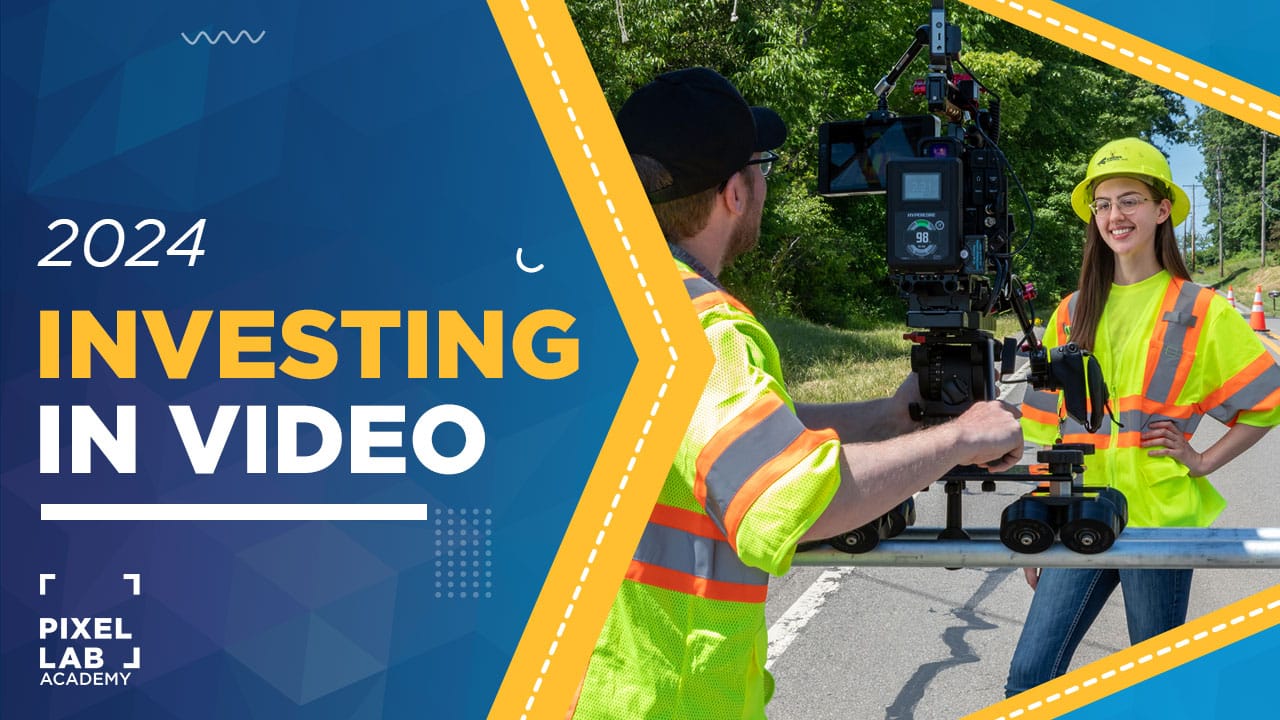If you’ve sifted through any of our other blog posts or paid the slightest bit of attention to digital marketing news, it’s likely that you’re aware of the positive impact video can have on your marketing strategy. But just because you’re producing video content doesn’t necessarily mean your content is converting.
A content strategy doesn’t just involve the initial planning, execution, and publishing (if only it were that easy!). The next necessary step to any sound digital strategy is measuring results and adjusting components of the strategy if things don’t seem to be working (this includes tweaking both creative and strategy elements).
So, how do we determine our video marketing ROI? Keep reading to learn how you can use marketing analytics to measure the success of your video marketing strategies.
1. Set Clear Goals and Establish KPIs
Before you even begin producing video marketing content, it’s important first to establish your campaign goals and select key performance indicators (KPIs) for how those goals will be measured.
In the graphic below, you can see the three primary stages of the marketing funnel and the key performance indicators you should focus on depending on which stage of the funnel your campaign is operating within.

Awareness KPIs
During this first stage of the customer journey, you want to introduce new people to your brand. The focus here is on reaching your target audience to generate brand awareness and warm them up to the idea of your brand and what you have to offer. This way, we slowly but surely guide them to eventually making a purchase.
KPIs that will help you determine your video marketing ROI in the Awareness stage include:
- Views / Impressions – The number of views your video has received during a specific period of time. This data is easily available for social media posts and ads (either through the native platform’s analytics tool or a third-party tool such as Sprout Social or Hootsuite).
- Reach – Similar to impressions, this metric shows the number of views your video has received, but these views are unique, meaning the data informs the amount of unique users who watched the video. To put this into context, a video with 100 impressions means that the video was seen 100 times. The same video may have a reach of 90, which means that 90 people viewed the video. This data tells us that the video was viewed 100 times in total by 90 people. As you build brand awareness, you’ll want to keep an eye on your reach to determine the number of people seeing your content.
- Website Visits – Whether you are launching a paid social advertisement, posting an organic social video, or utilizing video SEO to attract searchers to your page, you can track the amount of site visits that are likely attributed to your video content. Here’s how:
- Paid Social – The link click metric available in the backend of your paid social media platform will tell you how much site traffic is being driven by your video advertisement.
- Organic Social Posting – Here, you can use UTM links to track and measure the source of website traffic. Say, for example, you want to publish a video to Facebook with a link to a relevant landing page. You can add a tag to the URL to attribute each link click to that specific post. This data will be available in Google Analytics, and you can use Google’s Campaign URL Builder to set it all up. Pro-Tip: If you’ve got an organic social post that’s doing well, consider adding a boost of paid spend to reach more viewers and drive even more traffic to your site.
- Video SEO – Track the success of your website videos by monitoring the traffic being driven to your site via Google Analytics. Learn more about How to Use Video Marketing to Improve SEO and Search Rankings.
Consideration KPIs
During this second stage of the customer journey, you have already started to reach users in your target market. Now is the time to nurture them and earn their trust so they are funneled to the next stage, where they will officially become customers. In the Consideration stage, we can get more granular about our data. While the first stage (Awareness) focuses on getting as many eyeballs as possible on content, the Consideration stage is where we want to understand how these viewers are interacting with our content.
Key metrics that will help you determine our video marketing ROI in the Consideration stage include:
- Engagement Rate – This is calculated by combining all engagements (likes, comments, shares), dividing by total views, and multiplying by 100 to get a percentage. This data is available within your social media analytics tools, and your average marketer will tell you that Engagement Rate speaks volumes about how your social media marketing efforts are being received.
- Average View Duration – Watch time is an important metric that will help you gauge interest in your video content and brand.
- Social Media Mentions – You can use social media listening tools such as Brandwatch or Sprout Social to see the amount of buzz that’s been generated about your brand since launching your video campaign.
- Subscriber Growth – Tracking the growth of your social media followers or email subscribers as you launch your video marketing campaign will indicate how impactful your content is at generating brand interest.
Conversion KPIs
In this final stage of the marketing funnel, we want to track sales to measure the success of our video or video campaign. Metrics to track in the Conversion stage include:
- Conversion Rate – This percentage is calculated by taking the number of conversions and dividing it by the number of views, showcasing the effectiveness of your video in generating sales in relation to the number of people who saw it.
- Cost Per Conversion – This monetary piece of data is calculated by dividing your campaign’s total cost by the number of conversions. It will tell you exactly how much ad spend was used to generate each sale/conversion.

2. Determine Your Cost of Investment
Producing and promoting your video content requires considerable time and resources. So, once you are clear about your goals and how you plan to measure success, you can start taking your video production and marketing costs into consideration. Here is a list of items that may be relevant to the total cost of your video marketing campaign:
- Video Production Costs – How much are you investing in the creative and technical execution of your video assets? You’ll want to know How to Hire a Video Production Company that gets you the most bang for your buck while understanding the costs of producing a corporate video.
- Paid Ad Spend – Are you driving traffic to your marketing videos with paid ad spend? This is an important piece of information to include in your projected costs.
- Marketing Agency Fees – Working with an agency to hit your marketing goals? Make sure to include the associated costs when you plan to calculate video marketing ROI.
Once you have all of the costs associated with your investment summed up and your metrics data ready, you can move forward with calculating your ROI!
Key Takeaway
When planning a video marketing strategy, you’ll need to determine your campaign goals and key performance indicators. Then, you’ll use tracking tools to collect your data. Keeping track of the costs associated with your campaign will allow you to measure the ROI of your campaign.
3. Calculate ROI with Indirect Metrics Considered
At this point, you’ll have all the metrics you need to calculate the ROI of your video marketing endeavor(s). There are a couple of ways to calculate and conceptualize our data, so brace yourself for some number-crunching!
When we consider the ROI of any initiative, we usually use the formula:
ROI = [(Gain from Investment – Cost of Investment) / Cost of Investment] x 100
In the following two sections, you’ll learn how to calculate ROI for various stages of the marketing funnel described above.
Calculating indirect video ROI
Since the goals for the Awareness and Consideration stages are not necessarily to generate revenue just yet, calculating ROI requires some projecting and estimating. Let’s use an example to explain how this works:
Say you put $5K worth of resources into a video campaign to drive brand awareness. From your analytics software, you see that the campaign reached 50K new users. From past campaigns and industry insights, you know that 50K new users will generally lead to $3K in sales revenue as future campaigns move leads further down the marketing funnel.
So, let’s plug our marketing results into the formula mentioned above:
ROI = [(Gain from Investment – Cost of Investment) / Cost of Investment] x 100
ROI = [(3K – 5K) / 5K] x 100
ROI = -40%
Now, your heart may be pounding at the mere mention of a negative ROI. But fear not! When it comes to measuring indirect ROI at the beginning stages of the marketing funnel, a negative ROI isn’t necessarily a bad thing. In order to set yourself up for success in achieving maximum impact later on in the customer journey, you may have to sacrifice some initial budget to begin to nurture your target audience.
We know it can be tough, but patience is key here! Although a negative ROI typically indicates that the campaign did not generate enough revenue to cover its costs, negative ROIs may be acceptable when the long-term benefits (in this case- reaching new potential customers) outweigh the initial costs.
Calculating direct video ROI
Suppose your video content marketing strategy is geared toward the Conversion stage of the marketing funnel. In that case, you can establish a more traditional ROI percentage based on sales data that allows you to track the gain or loss generated from your campaign directly.
So, say you spent 5K on all costs associated with your conversion campaign. You collect data from your CRM or other platforms like social media or Google Analytics to determine that your conversions resulted in 12K worth of sales. Your ROI calculation would look like:
[(Sales – Cost of Investment) / (Cost of Investment)] x 100
[(12K – 5K) / (5K)] x 100
= 140% ROI
Congratulations! An ROI greater than 100% means that your campaign was profitable. In this case, not only did you manage to break even, but for every dollar spent on producing and promoting a video, you gained $1.40 in sales revenue. We love cost-efficient marketing efforts, don’t we?!

4. Use data to improve future video marketing strategies
Once you begin tracking the ROI of your video marketing campaign, you’ll want to use that data to inform your future strategies. The marketing industry and its best practices are ever-evolving, so the best we can do is monitor the performance of our strategies while paying attention to trends and do our best to optimize campaigns from there. One thing that’s certain is that leveraging video to promote your products or services is essential to compete with other brands across verticals. Here are some quick tips to improve the performance of your video marketing campaign:
- Include a clear and direct call to action that captures users’ attention and highlights benefits.
- Ensure your video content is story-driven (AKA, not just another annoying advertisement that users will scroll past).
- Create an engaging thumbnail that will drive interest and clicks to your video.
- Promote your video content using platforms you already use, such as social media or email marketing newsletters.
Key Takeaway
Once you’ve calculated the ROI of your video marketing efforts, you can use that data to optimize future campaigns by creating compelling content that converts and grows your business!








Leave a Comment